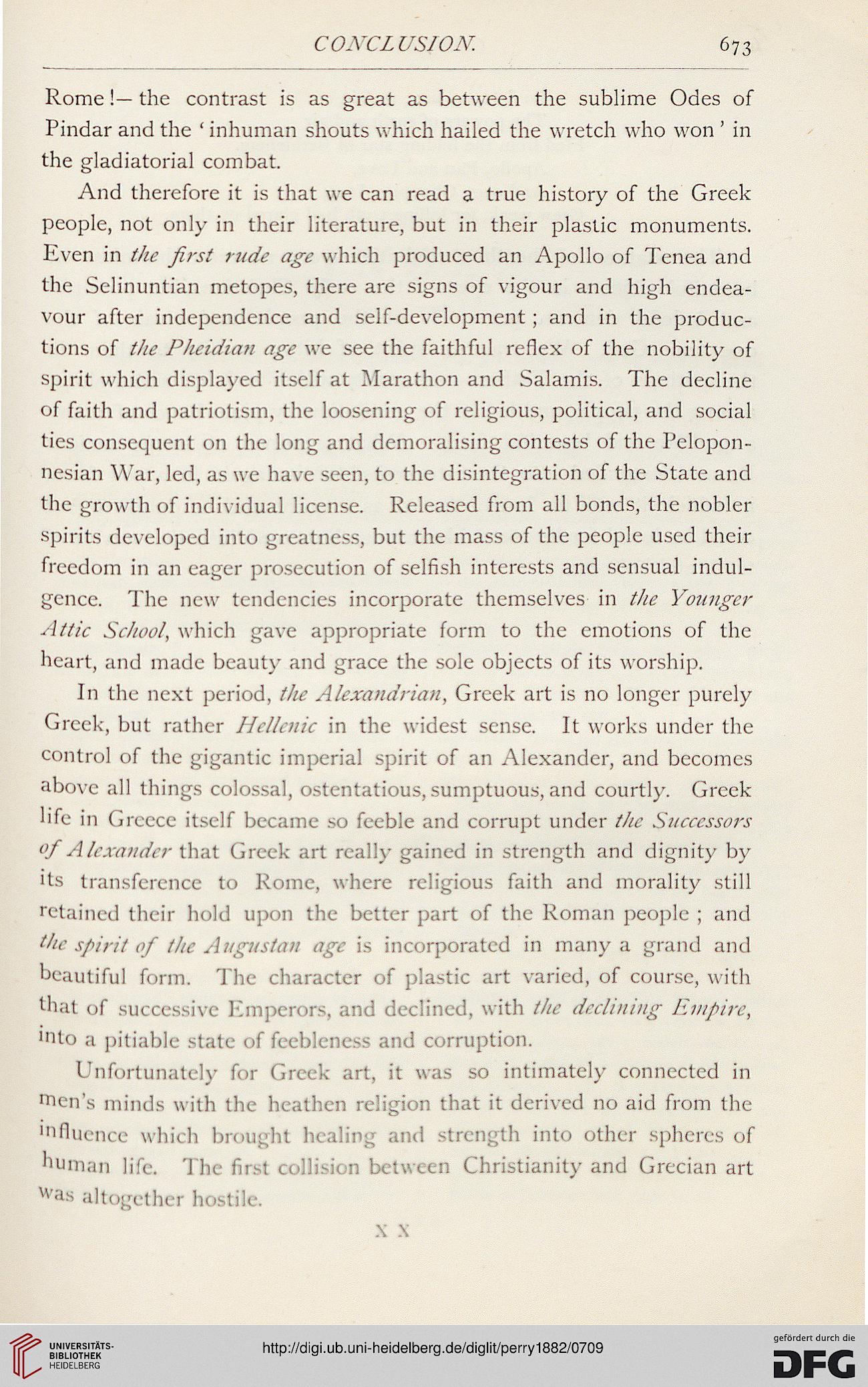COXCL USION.
673
Rome!— the contrast is as great as between the sublime Odes of
Pindar and the ' inhuman shouts which hailed the w retch who won ' in
the gladiatorial combat.
And therefore it is that we can read a true history of the Greek
people, not only in their literature, but in their plastic monuments.
Even in the first rude age which produced an Apollo of Tenea and
the Selinuntian metopes, there are signs of vigour and high endea-
vour after independence and self-development; and in the produc-
tions of tlie Pheidian age we see the faithful reflex of the nobility of
spirit which displayed itself at Marathon and Salamis. The decline
of faith and patriotism, the loosening of religious, political, and social
ties consequent on the long and demoralising contests of the Pelopon-
nesian War, led, as we have seen, to the disintegration of the State and
the growth of individual license. Released from all bonds, the nobler
spirits developed into greatness, but the mass of the people used their
freedom in an eager prosecution of selfish interests and sensual indul-
gence. The new tendencies incorporate themselves in the Younger
Attic School, which gave appropriate form to the emotions of the
heart, and made beaut}' and grace the sole objects of its worship.
In the next period, the Alexandrian, Greek art is no longer purely
Greek, but rather Hellenic in the widest sense. It works under the
control of the gigantic imperial spirit of an Alexander, and becomes
above all things colossal, ostentatious, sumptuous, and courtly. Greek
life in Greece itself became so feeble and corrupt under the Successors
°f Alexander that Greek art really gained in strength and dignity by
Its transference to Rome, where religious faith and morality still
retained their hold upon the better part of the Roman people ; and
the spirit of the Augustan age is incorporated in many a grand and
beautiful form. The character of plastic art varied, of course, with
that of successive Emperors, and declined, with the declining Empire,
"Uo a pitiable state of feebleness and corruption.
Unfortunately for Greek art, it was so intimately connected in
Hen's minds with the heathen religion that it derived no aid from the
■nfluence which brought healing and strength into other Spheres of
oilman life. The first collision between Christianity and Grecian art
*ta altogether hostile.
X .\
673
Rome!— the contrast is as great as between the sublime Odes of
Pindar and the ' inhuman shouts which hailed the w retch who won ' in
the gladiatorial combat.
And therefore it is that we can read a true history of the Greek
people, not only in their literature, but in their plastic monuments.
Even in the first rude age which produced an Apollo of Tenea and
the Selinuntian metopes, there are signs of vigour and high endea-
vour after independence and self-development; and in the produc-
tions of tlie Pheidian age we see the faithful reflex of the nobility of
spirit which displayed itself at Marathon and Salamis. The decline
of faith and patriotism, the loosening of religious, political, and social
ties consequent on the long and demoralising contests of the Pelopon-
nesian War, led, as we have seen, to the disintegration of the State and
the growth of individual license. Released from all bonds, the nobler
spirits developed into greatness, but the mass of the people used their
freedom in an eager prosecution of selfish interests and sensual indul-
gence. The new tendencies incorporate themselves in the Younger
Attic School, which gave appropriate form to the emotions of the
heart, and made beaut}' and grace the sole objects of its worship.
In the next period, the Alexandrian, Greek art is no longer purely
Greek, but rather Hellenic in the widest sense. It works under the
control of the gigantic imperial spirit of an Alexander, and becomes
above all things colossal, ostentatious, sumptuous, and courtly. Greek
life in Greece itself became so feeble and corrupt under the Successors
°f Alexander that Greek art really gained in strength and dignity by
Its transference to Rome, where religious faith and morality still
retained their hold upon the better part of the Roman people ; and
the spirit of the Augustan age is incorporated in many a grand and
beautiful form. The character of plastic art varied, of course, with
that of successive Emperors, and declined, with the declining Empire,
"Uo a pitiable state of feebleness and corruption.
Unfortunately for Greek art, it was so intimately connected in
Hen's minds with the heathen religion that it derived no aid from the
■nfluence which brought healing and strength into other Spheres of
oilman life. The first collision between Christianity and Grecian art
*ta altogether hostile.
X .\




